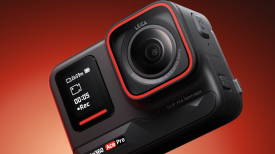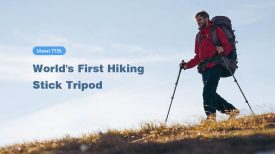Guest post by Nick Didlick:
As a video-shooter producer I am always on the hunt for new technologies to tell a video story. Recently Microsoft Research Computational Photography Group launched its anticipated Hyperlapse Pro application that was announced mid 2014. Hyperlapse for those that may not know is a time-lapse technique in which the camera is moved over long distances as opposed to timelapse where the camera is stationary or moves over a short distance.
I had a chance to get my hands on a pre-release copy of Hyperlapse Pro (Windows, Windows Azure, Windows Mobile, Android versions are available for trial download and integrated it into a short ski, bike, swim video Race You To The Lake.
Microsoft’s Hyperlapse Pro desktop app has a very simple interface and is extremely easy to use but the real power of the program lies in behind the interface in which Microsoft’s Computational Research Group leveraged its more than 20 years of research in imaging development. All you need is a video clip that has the cameras point of view moving over a distance. I found that clips of 2 to 30 minutes worked well and that they didn’t need the use of a gimbal or other stabilization device, as the programing behind Hyperlapse Pro will take care of that for you in most situations.
With your raw video footage in hand you import it into Hyperlapse Pro and choose a speed factor of 2 times to 25 times. The speed factor you choose will depend on how long you want your Hyperlapse sequence to run, and what you want your final sequence to look like.
There is a difference in the way hyperlapse applications fundamentally work to remove camera shake. Some use the cameras built in gyroscope to determine the amount of image warp between frames to give you a smooth playback, which works well if you are careful in your video capture. But in less controlled environments where you are shooting skiers and bikers using action cameras over unpredictable terrain these traditional methods of hyperlapse have a difficult time. This is where Microsoft says its approach to creating hyper lapse is fundamentally different from what others are doing.
This from Microsoft:
“It reconstructs a full 3D camera path and world model. This enables smoothing the camera path in space-time and generating an output video with a constant-speed camera, skipping over ‘slow’ parts of the input video, such as waiting times in front of red lights. Just as importantly, our method can fill the missing regions in the video above by stitching together pixels from multiple input frames. Thanks to these two innovations we can handle much ‘wilder’ input videos, such as climbing or riding.” (http://research.microsoft.com/en-us/um/redmond/projects/hyperlapse/igcomp/)
Microsoft lists some of Hyperlapse Pro Preview’s main features:
• Hyperlapse Pro Preview can take video from any camera and create a timelapse with a smoothly moving camera.
• It works especially well with wide field of view action camera videos, such as GoPro.
• Supports different speed up factors from 2x to 25x.
• Hyperlapses can be output at different resolutions and framerates.
• Takes advantage of multi-core CPUs and high-end GPUs for better processing speeds.
• A step-by-step user interface makes it easier than ever to create hyperlpases.
System Requirements:
Microsoft Hyperlapse Pro Preview works only with 64-bit versions of Windows Windows 7, Windows 8, or Windows 8.1. Minimum of 4GB of RAM (longer or higher resolution videos require more memory). OpenGL 2.0 or newer graphics card for faster performance.
One of the biggest advantages of the Hyperlapse app is that the final video footage is a file you can easily share anywhere with almost unlimited length or integrate your hyperlapsed footage into your video production.
To find out more go to (http://research.microsoft.com/en-us/um/redmond/groups/ivm/technology.htm)





